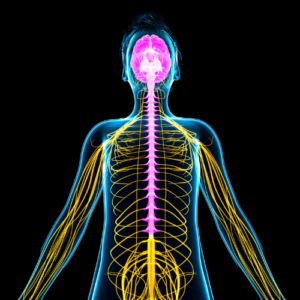If you’re feeling stressed, on edge, exhausted, or just “off”, your nervous system may need a reset. When we face excessive pressures and demands, our body’s built-in stress response system can get thrown out of whack.
This 3-day reset plan can help you re-balance your cortisol levels, calm your nerves, and get back to feeling like yourself again.
But first, what exactly is the nervous system, and why does it matter?
Simply put, the nervous system is the body’s command center. It controls everything from heart rate and digestion to energy levels and mood. The autonomic nervous system has two main modes:
Parasympathetic mode – This is the “rest and digest” state when the body is calm, and cortisol levels are low. You feel relaxed, grounded, and at ease.
Sympathetic mode – The “fight, flight, or freeze” response. It kicks in when a threat is perceived, jolting you into high alert. Cortisol levels spike to give you a burst of energy and focus.

Ideally, the nervous system should toggle between these two states as needed. But chronic stress can keep us stuck in overdrive, leading to high cortisol levels and symptoms like:
- Anxiety, overwhelm, or panic
- Irritability and a short fuse
- Difficulty concentrating and memory issues
- Headaches and muscle tension
- Sleep problems and fatigue
- Weight gain, especially around the midsection
- Getting sick more often
Sound familiar? The good news is you can take steps to complete the stress response cycle and give your nervous system a chance to recover. Here’s a 3-day plan to get you started.

Day 1 – Mindful Breathing
Diaphragmatic breathing is one of the fastest ways to flip the switch from sympathetic to parasympathetic mode. Take 5-10 minutes today to practice slow, deep belly breaths. Put a hand on your stomach and focus on expanding the belly on the inhale and gently contracting it on the exhale. This activates the vagus nerve, your relaxation superhighway.
The vagus nerve is the longest cranial nerve, running from the brain stem down to the abdomen. It’s a key player in the parasympathetic nervous system, helping to slow heart rate, lower blood pressure, and promote digestion. When we breathe deeply and slowly, we stimulate the vagus nerve, sending a signal to the brain that it’s time to relax and unwind.
Here’s how to practice diaphragmatic breathing:
- Find a comfortable position, either sitting or lying down.
- Place one hand on your chest and the other on your belly.
- Inhale slowly through your nose, allowing your belly to expand outward. The hand on your chest should remain relatively still.
- Exhale slowly through pursed lips, feeling your belly gently contract inward.
- Continue this pattern for 5-10 minutes, focusing on making your exhales slightly longer than your inhales.
If your mind starts to wander, gently redirect your attention back to your breath. It’s normal for thoughts to arise; just observe them without judgment and let them pass like clouds in the sky.
Plus, to add to activating the relaxation response, deep breathing also helps to oxygenate the blood, improve circulation, and release muscle tension. By making mindful breathing a regular practice, you can train your body to handle stress more effectively and bounce back from challenges more quickly.

Day 2 – Nourishing Your Nervous System
What we eat plays a big role in how we feel, both physically and emotionally. A diet high in processed foods, sugar, and caffeine can leave us feeling jittery, anxious, and depleted. On the other hand, eating nutrient-dense whole foods can help to stabilize blood sugar, support healthy brain function, and calm an overactive stress response.
Here are some of the best foods to include in your diet for a healthy nervous system:
- Leafy greens: Rich in magnesium, a mineral that helps to relax the nervous system and promote restful sleep. Try adding a handful of spinach to your morning smoothie or enjoying a big salad for lunch.
- Omega-3 fatty acids: Found in fatty fish like salmon, as well as in chia seeds, flaxseeds, and walnuts. Omega-3s are known for their anti-inflammatory properties and have been shown to help reduce anxiety and depression.
- Complex carbohydrates: Provide a steady source of energy for the brain and body, helping to keep blood sugar levels stable. Good options include sweet potatoes, quinoa, and oats.
- Turkey: Contains tryptophan, an amino acid that gets converted into serotonin in the body. Serotonin is a neurotransmitter that helps to regulate mood, sleep, and appetite.
- Berries: Packed with antioxidants that help to protect the brain from oxidative stress and inflammation. Blueberries, in particular, have been shown to improve memory and cognitive function.
- Dark chocolate: Rich in magnesium and theo-bromine, a compound that has a mild stimulating effect on the brain. Look for organic chocolate with at least 70% cocoa content and enjoy in moderation.
Plus, to add to adding these foods to your diet, it’s also important to stay hydrated by drinking plenty of water throughout the day. Even mild dehydration can cause fatigue, headaches, and difficulty concentrating.
Challenge yourself to include at least one nervous system-supporting food in each meal today. Notice how you feel after eating these nourishing foods compared to when you rely on quick fixes like sugar and caffeine.

Day 3 – Face & Jaw Release
Facial tensions are a mirror of the mind. When we are stressed, we often clench the jaw or furrow the brow without realizing it. Over time, these unconscious habits can lead to chronic pain, headaches, and even tooth damage.
Taking a few minutes each day to release tension in the face and jaw can have a profound effect on your overall sense of wellbeing. Here’s a simple exercise to try:
- Find a comfortable seated position and close your eyes.
- Take a few deep breaths, allowing your body to settle and your mind to quiet.
- Begin by softening your gaze and relaxing your eyes. Imagine the space between your eyebrows getting wider and your forehead becoming smooth.
- Un-clench your jaw and let your mouth fall open slightly. You may feel an immediate sense of relief as you release the tension you were holding.
- Gently move your jaw from side to side a few times, then open your mouth wide and release a silent sigh.
- Relax your tongue and let it fall away from the roof of your mouth.
- Continue to breathe deeply as you scan your face for any other areas of tension, consciously releasing them with each exhale.
You may be surprised at how much lighter and more peaceful you feel after just a few minutes of this practice. The face and jaw are common areas where we hold stress and emotion, so by releasing physical tension here, we also create an opportunity for mental and emotional release.
Plus, to add to this daily practice, you can also try self-massage techniques to further relax the face and jaw. Using your fingertips, gently massage your temples, forehead, cheeks, and jaw in small circular motions. You can also place a warm compress over your face for a few minutes to help soften and soothe tense muscles.
Remember, the goal is not to force yourself to relax, but rather to invite a sense of ease and openness. If you notice yourself clenching or holding tension during the day, simply take a moment to pause, breathe, and release.
Adding these practices into your daily routine can help to regulate your nervous system, reducing the physical and mental symptoms of stress over time. But it’s important to remember that true healing is a journey, not a quick fix.

Be patient and kind with yourself as you navigate this process. Some days will feel easier than others, and that’s okay. Trust that by showing up for yourself each day and making small, consistent changes, you are laying the foundation for lasting resilience and well-being.
If you find yourself struggling to manage stress on your own, don’t hesitate to reach out for support. Working with a health coach, therapist, or other holistic practitioner can provide valuable guidance and accountability as you work to rebalance your nervous system and create a life that feels nourishing and sustainable.
Remember, you are not alone in this journey. Stress is a universal human experience, and there is no shame in seeking help when you need it. By prioritizing your own self-care and learning to tune into your body’s wisdom, you are taking a powerful step towards greater health, happiness, and resilience.
So take a deep breath, give yourself a pat on the back, and keep going. You’ve got this! With time, patience, and practice, you can restore balance to your nervous system and reclaim your sense of inner peace and vitality.
